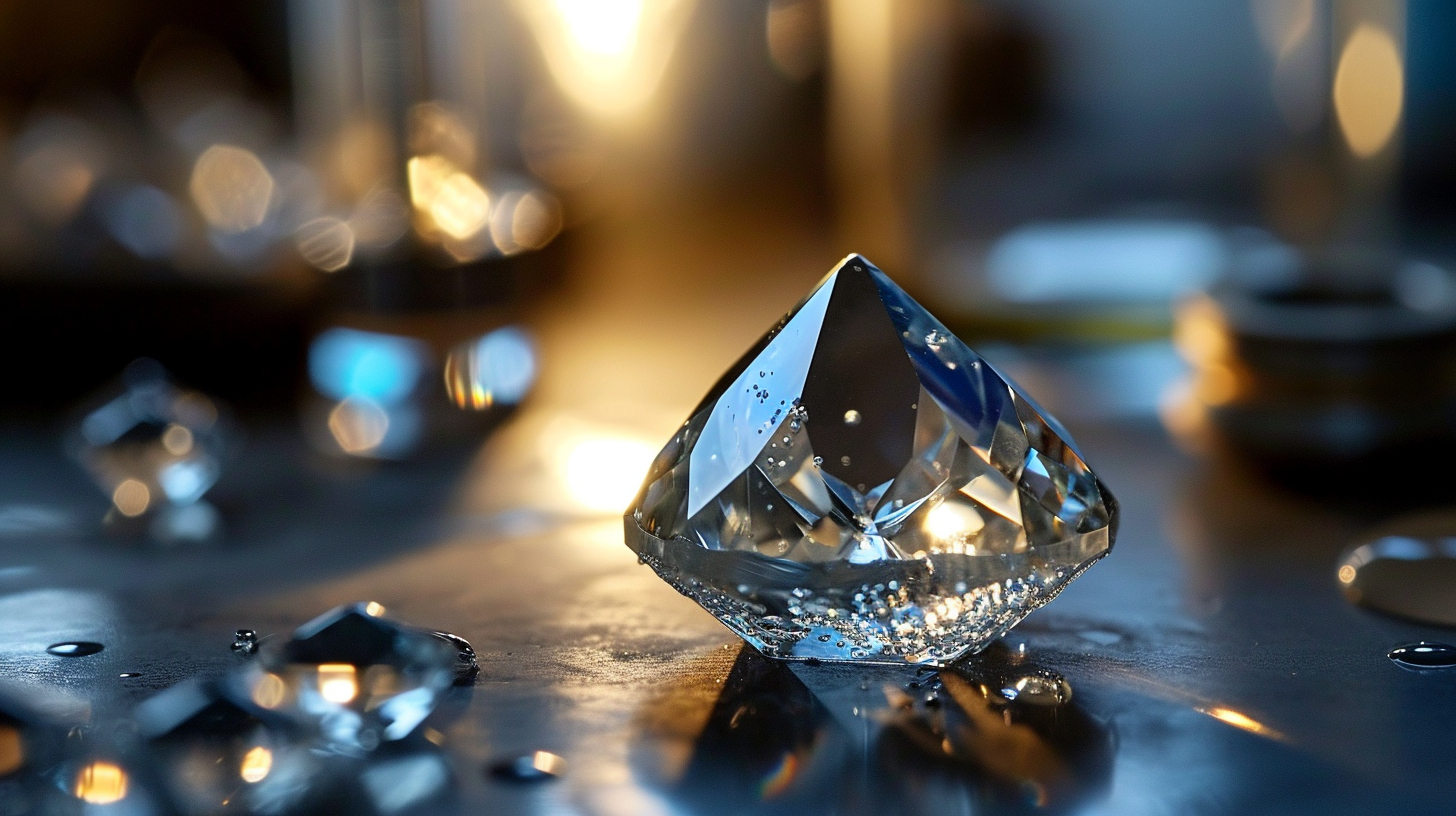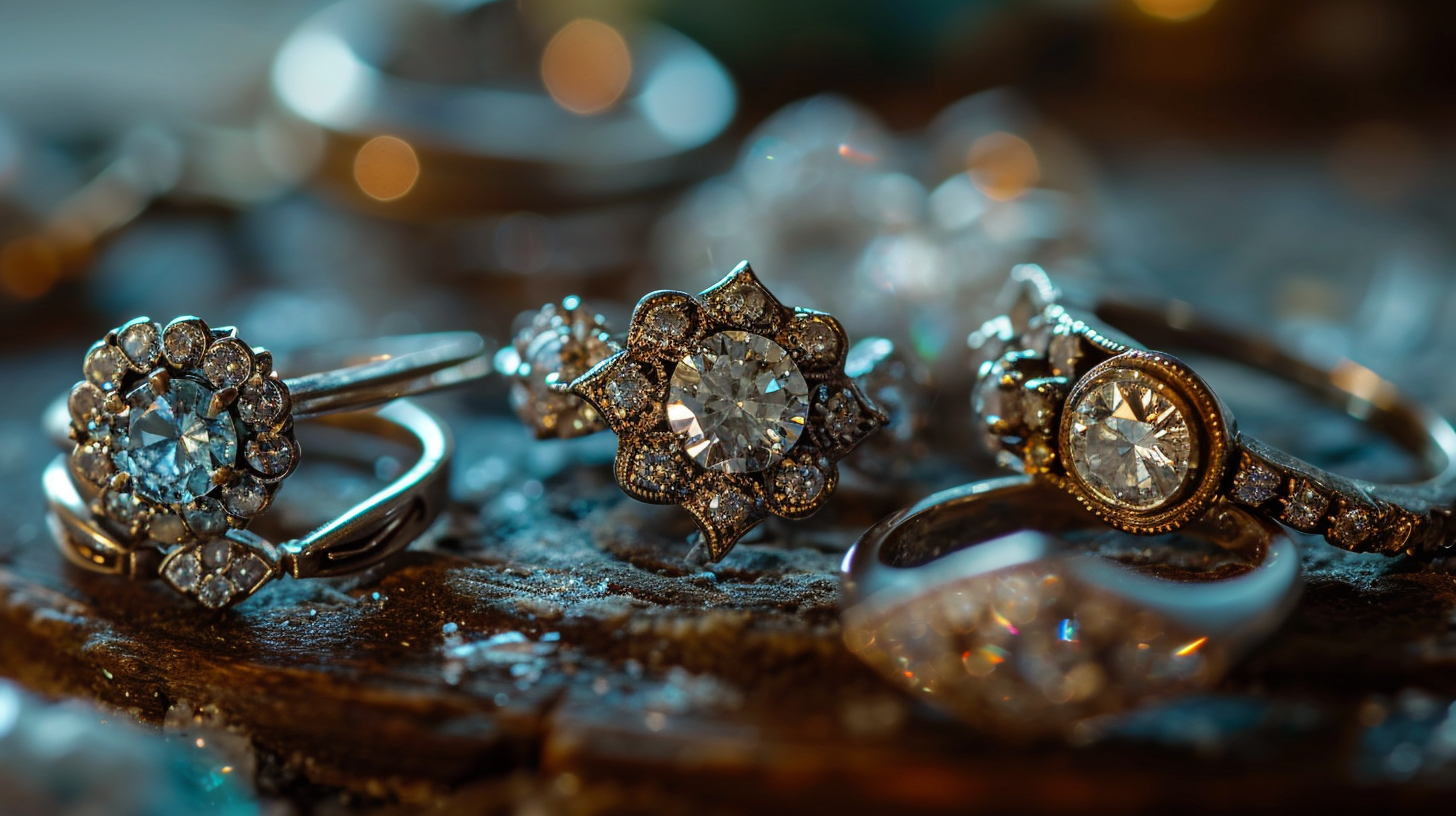26th Dec 2023
A Greener Promise: Finding the Perfect Eco-Friendly Engagement Rings
Understanding Eco-Friendly Engagement Rings
As consumers become more conscious of their impact on the environment, the demand for sustainable and ethical products extends into all aspects of life, including the search for the perfect engagement ring. Here, we delve into what makes an engagement ring eco-friendly and the importance of ethically-sourced materials.
What Makes an Engagement Ring Eco-Friendly
Eco-friendly engagement rings are made using ethically-sourced gemstones and recycled metals, significantly reducing their impact on the environment source. These sustainable options include lab-grown diamonds, which are not mined and have a lower carbon footprint compared to natural diamonds, and vintage or antique diamonds, which reduce the need for new diamond mining and preserve the earth's resources source.
Engagement rings made with recycled metals prevent deforestation and minimise carbon emissions associated with mining new metals. By choosing an eco-friendly engagement ring, one can contribute towards preserving the environment and promoting sustainable practices in the jewellery industry.
The Importance of Ethically-Sourced Materials
Beyond being environmentally responsible, eco-friendly engagement rings also promote social and economic fairness. Ethical mining practices, such as those involved with Fairtrade gold, ensure that miners are paid fair wages and work in safe conditions source.
The jewellery industry has historically caused significant environmental damage and social impact due to the mining process of precious materials. This includes habitat destruction, soil erosion, water pollution, and accusations of human rights violations, child labour, and worker exploitation Body Piercing.
By choosing ethically-sourced materials for engagement rings, consumers can help to combat these issues. As we move towards a more sustainable future, the demand for eco-friendly engagement rings is expected to rise further. To learn more about sustainable options, explore our guide to sustainable jewellery brands and handmade sustainable jewellery.
The Rise in Demand for Eco-Friendly Rings
As the world becomes more aware of the importance of sustainable practices, there has been a notable increase in the demand for eco-friendly engagement rings. This trend is driven by shifting consumer choices and the emergence of certification programs that ensure the ethical production of jewellery.
Shifting Consumer Choices
The demand for ethically sourced and eco-friendly engagement rings has been steadily increasing in recent years, indicating a shift towards more sustainable and responsible consumer choices. More and more couples are prioritizing sustainability and ethical practices in their purchasing decisions, driving the demand for eco-conscious jewellery. This trend has also been supported by the growth of sustainable jewellery brands that prioritize ethical sourcing and production methods.
Choosing to buy sustainable jewellery and supporting companies that prioritize sustainability is an important step towards making the jewellery industry more sustainable. Consumers can make a difference by making informed choices and advocating for sustainable jewellery.
The Role of Certification Programs
In response to the rising demand for ethical and sustainable jewellery, various organizations and certification programs have been established to ensure transparency and accountability in the production and sale of eco-friendly engagement rings.
Certification bodies such as the Responsible Jewellery Council (RJC) provide guidelines and standards for ensuring the ethical and sustainable production of engagement rings and other jewellery. These programs help consumers identify and select fair-trade jewellery from brands that are committed to sustainable practices.
By looking for RJC-certified brands when shopping for eco-friendly engagement rings, consumers can ensure they are supporting companies that prioritize ethical sourcing and production methods.
The rise in demand for eco-friendly rings marks a positive shift in consumer attitudes towards sustainability and ethical practices. By taking the time to research and choose sustainable and ethically produced engagement rings, consumers can contribute to a more sustainable future for the jewellery industry.

Eco-Friendly Materials for Engagement Rings
When exploring options for eco-friendly engagement rings, the materials used are paramount. These rings are made using ethically-sourced gemstones and recycled metals, reducing their impact on the environment (source). In this section, we'll delve into some popular material choices for eco-friendly rings: lab-grown diamonds, recycled metals, and vintage or antique diamonds.
Lab-Grown Diamonds: An Eco-Friendly Choice
Lab-grown diamonds are an increasingly popular choice for eco-conscious consumers. These diamonds are not mined, but rather developed in a laboratory under high pressure and high temperature conditions. The resulting diamonds are virtually identical to natural diamonds, but come with a significantly lower carbon footprint (Shiny Rock Polished).
Choosing lab-grown diamonds also helps to reduce the social and environmental impact associated with traditional diamond mining. Less disruption to ecosystems and fairer working conditions make lab-grown diamonds a truly sustainable choice for eco-conscious jewellery.
The Use of Recycled Metals
Another factor that plays into the eco-friendly status of an engagement ring is the metal used in its band. Eco-friendly engagement rings often utilise recycled metals, which reduces the need for new mining and the associated environmental impact.
Recycled metals can come from a variety of sources, including outdated jewellery, industrial-use metals, and even electronics. These metals are melted down and repurposed into new pieces of jewellery, offering a new life for materials that would otherwise be discarded.
In addition, some eco-friendly engagement rings use metals sourced from ethical mining practices, such as Fairtrade gold. This ensures that the miners are paid fair wages and work in safe conditions, contributing to the overall sustainability of the piece (source).
The Appeal of Vintage and Antique Diamonds
Vintage and antique diamonds are another excellent choice for eco-friendly engagement rings. These diamonds have been previously cut and set in jewellery, and can be repurposed into new pieces. This reduces the need for new diamond mining, preserving the earth's resources.
Choosing a vintage or antique diamond not only has environmental benefits, but also adds a sense of history and uniqueness to an engagement ring. Each vintage diamond is unique, offering a one-of-a-kind beauty that's perfect for expressing a timeless love.
Through these material choices, it's possible to find an engagement ring that aligns with both your personal style and your commitment to sustainability. Explore more sustainable jewellery brands and make an informed choice for your special piece.
The Environmental Impact of Traditional Jewelry
While traditional jewellery can be beautiful and sentimental, the environmental and social impacts of its production can be significant. This section will explore these impacts with a focus on diamond mining and the social repercussions within the jewellery industry.
Negative Effects of Diamond Mining
Diamond mining, particularly for engagement rings, often leads to severe environmental consequences. This includes deforestation, pollution, and habitat destruction, all of which contribute to biodiversity loss.
The extraction process of precious materials like gold, silver, and diamonds is not only environmentally damaging but also energy-intensive. It releases significant amounts of CO2 into the atmosphere, contributing to global warming. The use of harmful chemicals like mercury and cyanide in the extraction process often leads to water pollution as these substances can leak into waterways (Body Piercing).
For example, the production of a single carat of gold releases 57 kg of carbon, while shifting 250 tons of earth is a common occurrence for the extraction of a single diamond carat (SCS Global Services).
The Social Impact of the Jewelry Industry
In addition to the environmental impact, the traditional jewellery industry is associated with numerous social and political concerns. Over 100 million people work in the industry, many of whom are based in economically depressed areas in third-world countries, where artisanal mining is often carried out illegally. This contributes to issues such as slave labor, pollution, and exploitation (SCS Global Services).
Furthermore, the industry has been linked to human displacement, environmental changes that reduce quality of life, child labor, and dangerous working conditions. In fact, in South Africa, miners have a 20% higher mortality rate than the rest of the population.
These issues have led to a growing interest in eco-conscious jewellery, including eco-friendly engagement rings and handmade sustainable jewellery. By making informed choices and supporting sustainable jewellery brands, consumers can help to promote better ethical practices within the industry.
Affordable Options for Eco-Friendly Rings
Choosing eco-friendly engagement rings doesn't have to come with a hefty price tag. There are several affordable options available, which are not only kind to your wallet but also to the environment.
The Appeal of Gemstone Engagement Rings
Gemstone engagement rings are becoming increasingly popular as an affordable and eco-friendly alternative to traditional diamond rings. Gemstones such as aquamarine, pink tourmaline, and iolite offer a unique and personal touch to engagement rings, whilst also being more cost-effective.
Gemstone rings are also a great choice for those looking for a colourful and distinctive ring. They can be sourced ethically, ensuring that your ring has a minimal environmental impact. For a list of brands offering gemstone rings, consider our article on sustainable jewellery brands.
Moissanite Rings: An Affordable Alternative
Moissanite rings are another budget-friendly option for eco-conscious couples. These rings feature a stone that has the same qualities as real diamonds but come at a fraction of the cost.
Moissanite is a lab-grown gemstone, which means it is created without the environmental damage caused by traditional mining. Its brilliance and durability make it an attractive alternative for those seeking affordable eco-friendly engagement rings.
Other affordable options for engagement rings include composite diamond rings, which feature smaller carat diamonds set together to create the impression of a larger carat diamond, and cubic zirconia rings. However, when considering cubic zirconia, it's crucial to exercise caution and avoid rings made with brass or copper plated with gold or silver.
Inexpensive engagement rings are indeed a possibility, but it requires wise shopping and thinking outside the box. Embrace alternative materials to diamonds and consider vintage and estate rings for a ring that is both affordable and eco-friendly. For more information, check out our article on eco-conscious jewellery.
Brands Specializing in Eco-Friendly Rings
While the search for eco-friendly engagement rings might seem daunting, many brands are dedicated to sustainable and ethical practices. These brands are not only focused on creating beautiful jewellery but also on ensuring their processes are as eco-friendly as possible.
Ken & Dana Design's Sustainability Commitment
One such brand making waves in the world of sustainable jewellery is Ken & Dana Design. They offer a collection of eco-friendly engagement rings made from ethically sourced lab-grown diamonds and recycled precious metals (Ken & Dana Design). By reducing reliance on traditional diamond mining and metal extraction processes, Ken & Dana Design minimizes the environmental impact of their products.
The lab-grown diamonds used in their rings are chemically, physically, and visually identical to mined diamonds, but are created in a controlled laboratory environment using advanced technology. This process ensures the diamonds are conflict-free and do not contribute to the destruction of natural habitats associated with traditional diamond mining (Ken & Dana Design).
Moreover, the recycled precious metals used in Ken & Dana Design's rings are sourced from refineries that adhere to strict environmental and labour standards. This approach ensures the metals are not contributing to harmful mining practices or unethical labour conditions. Using recycled metals reduces the demand for new mining, thus lessening the associated environmental damage (Ken & Dana Design).
Ken & Dana Design is committed to transparency and offers detailed information about the origin and sourcing of their materials. They trace their diamonds back to the laboratory where they were grown and provide certificates of origin for their metals. This way, customers can make informed choices about the ethical and environmental impact of their engagement ring purchase.
In addition to sustainable materials, Ken & Dana Design invests in carbon offset programs to neutralize the environmental impact of their operations. They purchase carbon offsets to compensate for the emissions produced during the manufacturing and shipping processes, making their engagement rings an even more eco-friendly choice.
Other Brands Prioritizing Eco-Friendly Practices
Ken & Dana Design is not the only brand committed to sustainable practices. Many other brands are also prioritizing eco-friendly practices in their jewellery production. These include the use of recycled materials, ethically sourced gemstones, and fair-trade practices. For more information on brands dedicated to sustainability, visit our article on sustainable jewellery brands.
By choosing to purchase from these brands, consumers can contribute to a more sustainable and ethical jewellery industry. Making a conscious choice for eco-friendly engagement rings is a significant step in promoting sustainable practices and reducing the environmental impact of the jewellery industry. For more insights on eco-conscious jewellery, check out our eco-conscious jewellery guide.
Making Informed Choices for Sustainable Jewelry
As the demand for eco-friendly products rises, consumers play a pivotal role in shaping the market for sustainable jewelry. This section will explore the significance of consumer choices in promoting sustainable practices within the jewelry industry and offer guidance on selecting the right materials for eco-friendly engagement rings.
The Role of Consumers in Sustainable Jewelry
Consumers can make a significant impact on the jewelry industry by opting for sustainable jewelry brands. By choosing eco-friendly engagement rings, consumers can help reduce the negative environmental and social impacts associated with traditional jewelry production. These impacts include issues such as deforestation, soil contamination, and poor working conditions.
Additionally, a growing preference for sustainable engagement rings can incentivize more brands to adopt eco-friendly practices and increase transparency in their supply chains. For instance, certifications like Fairtrade Gold and Fairmined Gold ensure that fair trade principles are followed and that the journey of the jewelry from mine to customer is traceable.
Choosing the Right Materials for Your Ring
When selecting an eco-friendly engagement ring, the choice of material is an important consideration. Opting for materials such as lab-grown diamonds or recycled metals can significantly reduce the environmental impact of your ring. Furthermore, vintage or antique diamonds can be an excellent choice for those seeking a unique and history-rich piece of jewelry.
Before making a purchase, it's important to research the practices of the brand or jeweller. Look for brands that prioritize sustainability and ethical sourcing of materials. If possible, choose brands that offer traceability for their products to ensure that they adhere to fair trade principles.
Consumers can also consider other alternatives such as fair trade jewellery and handmade sustainable jewellery for unique, artisan-crafted pieces that support local communities and uphold ethical practices.
By making informed choices, consumers can play a crucial role in promoting sustainability within the jewelry industry. Through our collective efforts, we can help pave the way for a greener and more ethical future in jewelry production.


